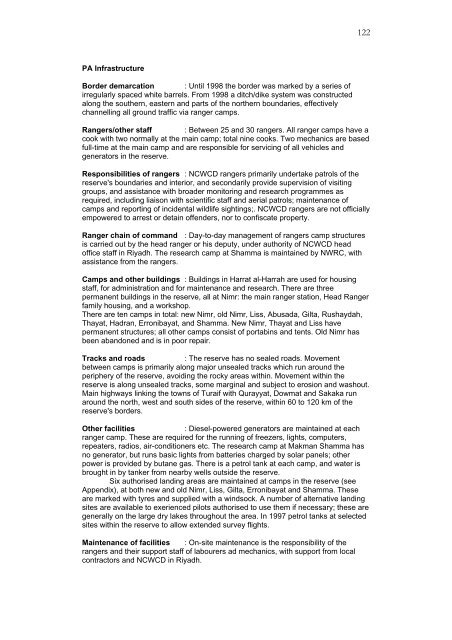The Unfenced Desert Towards a strategy for eco ... - Nwrc.gov.sa
The Unfenced Desert Towards a strategy for eco ... - Nwrc.gov.sa
The Unfenced Desert Towards a strategy for eco ... - Nwrc.gov.sa
Create successful ePaper yourself
Turn your PDF publications into a flip-book with our unique Google optimized e-Paper software.
PA Infrastructure<br />
Border demarcation : Until 1998 the border was marked by a series of<br />
irregularly spaced white barrels. From 1998 a ditch/dike system was constructed<br />
along the southern, eastern and parts of the northern boundaries, effectively<br />
channelling all ground traffic via ranger camps.<br />
122<br />
Rangers/other staff : Between 25 and 30 rangers. All ranger camps have a<br />
cook with two normally at the main camp; total nine cooks. Two mechanics are based<br />
full-time at the main camp and are responsible <strong>for</strong> servicing of all vehicles and<br />
generators in the reserve.<br />
Responsibilities of rangers : NCWCD rangers primarily undertake patrols of the<br />
reserve's boundaries and interior, and s<strong>eco</strong>ndarily provide supervision of visiting<br />
groups, and assistance with broader monitoring and research programmes as<br />
required, including liaison with scientific staff and aerial patrols; maintenance of<br />
camps and reporting of incidental wildlife sightings;. NCWCD rangers are not officially<br />
empowered to arrest or detain offenders, nor to confiscate property.<br />
Ranger chain of command : Day-to-day management of rangers camp structures<br />
is carried out by the head ranger or his deputy, under authority of NCWCD head<br />
office staff in Riyadh. <strong>The</strong> research camp at Shamma is maintained by NWRC, with<br />
assistance from the rangers.<br />
Camps and other buildings : Buildings in Harrat al-Harrah are used <strong>for</strong> housing<br />
staff, <strong>for</strong> administration and <strong>for</strong> maintenance and research. <strong>The</strong>re are three<br />
permanent buildings in the reserve, all at Nimr: the main ranger station, Head Ranger<br />
family housing, and a workshop.<br />
<strong>The</strong>re are ten camps in total: new Nimr, old Nimr, Liss, Abu<strong>sa</strong>da, Gilta, Rushaydah,<br />
Thayat, Hadran, Erronibayat, and Shamma. New Nimr, Thayat and Liss have<br />
permanent structures; all other camps consist of portabins and tents. Old Nimr has<br />
been abandoned and is in poor repair.<br />
Tracks and roads : <strong>The</strong> reserve has no sealed roads. Movement<br />
between camps is primarily along major unsealed tracks which run around the<br />
periphery of the reserve, avoiding the rocky areas within. Movement within the<br />
reserve is along unsealed tracks, some marginal and subject to erosion and washout.<br />
Main highways linking the towns of Turaif with Qurayyat, Dowmat and Sakaka run<br />
around the north, west and south sides of the reserve, within 60 to 120 km of the<br />
reserve's borders.<br />
Other facilities : Diesel-powered generators are maintained at each<br />
ranger camp. <strong>The</strong>se are required <strong>for</strong> the running of freezers, lights, computers,<br />
repeaters, radios, air-conditioners etc. <strong>The</strong> research camp at Makman Shamma has<br />
no generator, but runs basic lights from batteries charged by solar panels; other<br />
power is provided by butane gas. <strong>The</strong>re is a petrol tank at each camp, and water is<br />
brought in by tanker from nearby wells outside the reserve.<br />
Six authorised landing areas are maintained at camps in the reserve (see<br />
Appendix), at both new and old Nimr, Liss, Gilta, Erronibayat and Shamma. <strong>The</strong>se<br />
are marked with tyres and supplied with a windsock. A number of alternative landing<br />
sites are available to exerienced pilots authorised to use them if neces<strong>sa</strong>ry; these are<br />
generally on the large dry lakes throughout the area. In 1997 petrol tanks at selected<br />
sites within the reserve to allow extended survey flights.<br />
Maintenance of facilities : On-site maintenance is the responsibility of the<br />
rangers and their support staff of labourers ad mechanics, with support from local<br />
contractors and NCWCD in Riyadh.

















